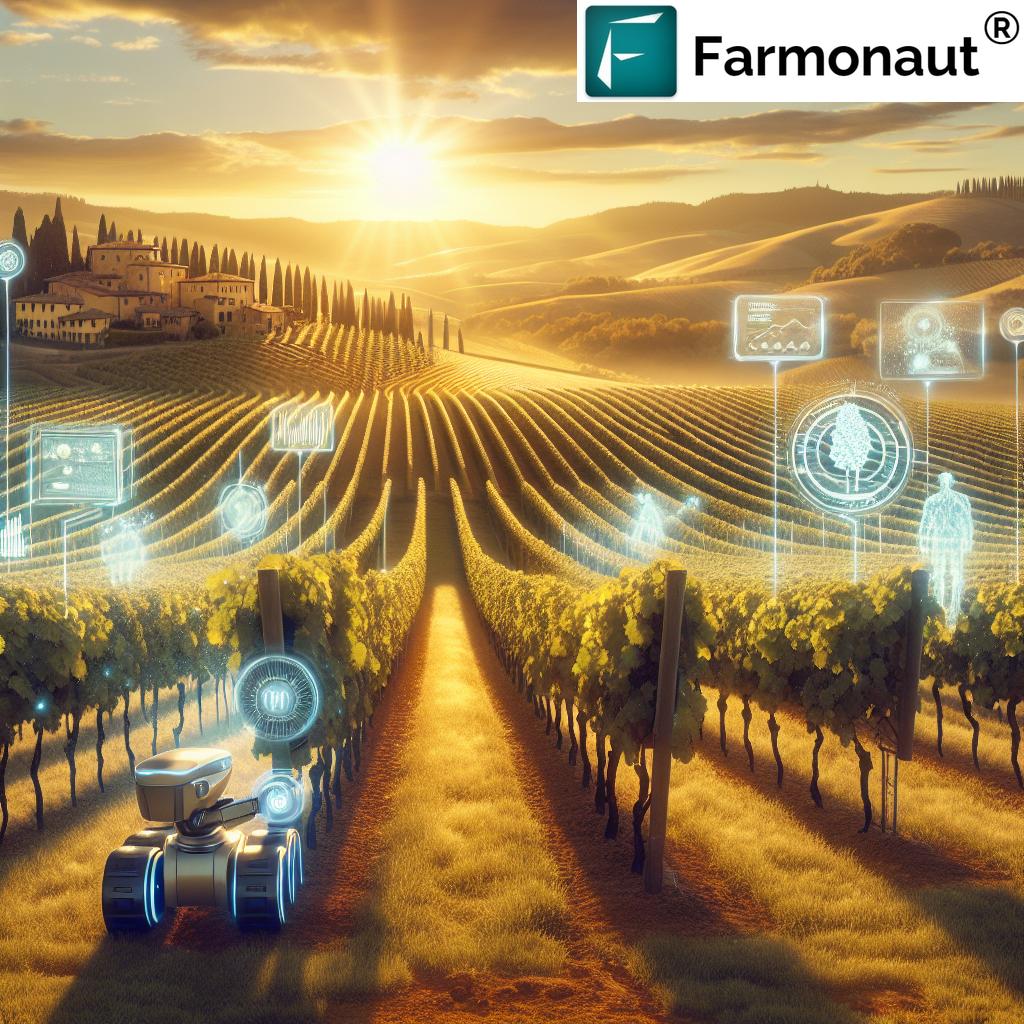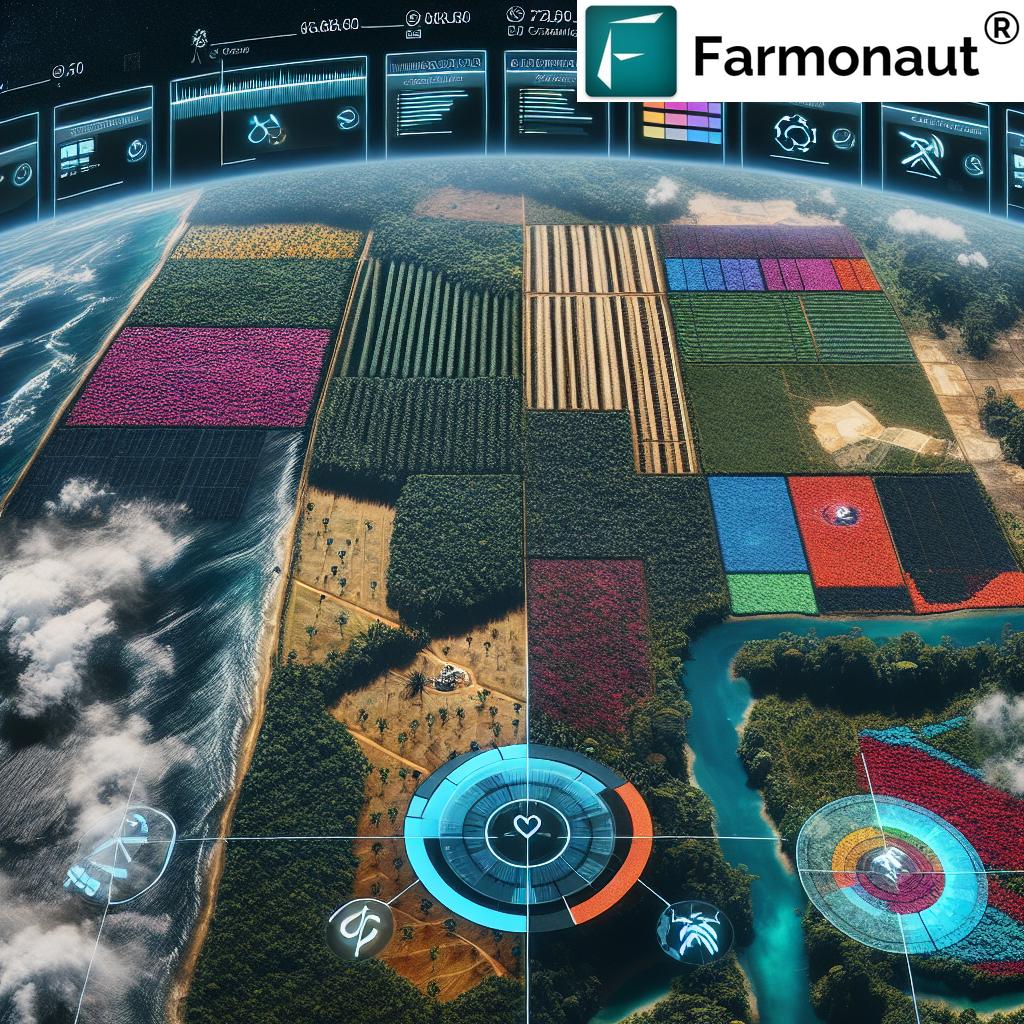Moldova Agriculture: Renewable Energy & Farming 2025
Meta Description: Moldova agriculture is transforming in 2025, integrating renewable energy for sustainable farming, boosting yields, and environmental stewardship. Explore how Moldova Farming SRL and the sector lead this green future.
Table of Contents
- Key Trivia: Moldova’s Energy Revolution
- Introduction: Moldova Agriculture at a Pivotal Juncture (2025)
- Agriculture Landscape in Moldova (2025)
- Modernization & Sustainability: Emerging Trends in Moldova Agriculture
- Integrating Renewable Energy and Farming in Moldova
- Estimated Impact of Renewable Energy Integration in Moldova Agriculture (2025)
- Renewable Energy Technologies & Sustainable Practices
- Access, Empowerment, and Viable Solutions for Moldova’s Farmers
- Farmonaut: Satellite-Driven Solutions for Moldova Agriculture
- More Trivia from Moldova Agriculture 2025
- Benefits & Future Perspectives: Moldova Agriculture 2025
- Frequently Asked Questions (FAQ)
- Conclusion: Moldova’s Sustainable Agrarian Future
“Moldova aims for 30% of its agricultural energy to come from renewables by 2025, up from 12% in 2020.”
Introduction: Moldova Agriculture at a Pivotal Juncture (2025)
Moldova agriculture in 2025 stands at a remarkable crossroads. As the backbone of the country’s economy, contributing significantly to employment, exports, and rural livelihoods, the agricultural sector is undergoing unprecedented transformation. Agriculture Moldova has always been recognized for its productive soils, favorable climate, and a strong tradition in crop and livestock production. But new challenges—climate change, the need for sustainability, and economic pressures—demand bold modernization and green energy solutions.
This article explores how Moldova agriculture is integrating renewable energy and sustainable practices in 2025 to enhance yields, boost efficiency, and champion environmental stewardship. We emphasize the role of pioneering entities like Moldova Farming SRL and technologies that are reshaping the landscape for farmers, stakeholders, and rural communities.
Agriculture Landscape in Moldova (2025)
The Backbone of Moldova’s Economy
For decades, agriculture Moldova has been the central pillar of Moldova’s economy—accounting for about one-third of total employment and a substantial portion of exports. The sector is dominated by small and family farms, yet agricultural enterprises—such as Moldova Farming SRL—are playing an increasingly crucial role in modernizing operations. These enterprises are introducing a new era that blends tradition with innovation and environmental consciousness.
Natural Advantages and Crop Diversity
The country is blessed with fertile chernozem soils and a climate that favors a diverse variety of crops, including:
- Grains—wheat, barley, maize
- Fruits—apples, plums, cherries, apricots
- Vegetables—tomatoes, peppers, cucumbers
- Vineyards—making Moldova a leading wine producer in Eastern Europe
Despite these assets, several challenges have traditionally restricted the sector’s growth. Outdated equipment, limited access to finance, and vulnerability to climate change and market volatility have often posed significant barriers.
Family Farms and Enterprises: Roles and Synergies
Small and medium-sized family farms dominate the landscape, often working hand-in-hand with modern agribusiness enterprises. Moldova Farming SRL stands at the forefront—pioneering the adoption of advanced machinery, sustainable irrigation, and data-driven management practices that deliver quality, yield, and cost efficiency.
Current State and 2025 Outlook
By 2025, with government and international support, the sector is better positioned to overcome constraints and capture new opportunities—especially in the integration of green energy and smart technologies.
Modernization & Sustainability: Emerging Trends in Moldova Agriculture
The Transformative Shift in 2025
The sector is witnessing a transformative shift. Farmers and agribusinesses have embraced modernization, making full use of digital tools—like precision agriculture, soil mapping, and advanced irrigation management systems. These technologies help optimize inputs (such as fertilizers and water) and maximize yields while minimizing waste and resource depletion.
- Precision agriculture allows real-time crop monitoring and tailored interventions for each field.
- Soil mapping provides actionable data on soil health, nutrients, and water needs.
- Smart irrigation reduces costs, conserves water, and supports sustainable farming.
Moldova Farming SRL exemplifies this movement, showcasing efficient management and robust, data-driven operations. The drive for sustainability is now inseparable from strategies for productivity, growth, and environmental stewardship.
Integrating Renewable Energy and Farming in Moldova
Why Renewable Energy? Drivers and Needs
Climate variability, increasing energy costs, and environmental concerns have intensified the search for sustainable solutions in Moldova farming. Renewable energy and farming Moldova have become increasingly intertwined as farms look for viable and stable energy sources that reduce dependency on fossil fuels and decrease greenhouse gas emissions.
Key Drivers
- Domestic Initiatives: Moldova’s government has advanced policies and incentives to accelerate the adoption of renewables in rural and agricultural areas.
- International Support: Access to low-interest green financing, technical expertise, and market links from international entities supports rapid scale-up.
- Stakeholder Demand: Farmers, agribusinesses, and consumers increasingly demand environmentally friendly solutions and energy independence.
Types of Renewable Energy in Moldova Agriculture
- Solar Power: Photovoltaic installations provide electricity for irrigation, machinery, storage, and on-farm processing. Rooftop panels on barns and stables are common, while larger arrays serve field irrigation and greenhouses.
- Biogas: Digesters transform manure, crop residues, and farm waste into clean energy—powering machinery, heating facilities, and providing organic fertilizer.
- Wind Power: In select regions, wind turbines are being tested to supplement power needs, though adoption remains lower than solar.
- Biomass: Using crop residues and waste for producing heat and power, reducing the need for external energy sources.
These technologies are reshaping the way Moldova farming is practiced. They simultaneously address energy needs, minimize waste, and improve environmental outcomes—while boosting productivity and supporting long-term rural livelihoods.
Did you know? Many farms in Moldova Farming SRL’s networks operate year-round biogas plants, turning previous waste management challenges into new revenue streams and cleaner operations.
Financing: Reducing Barriers, Boosting Growth
Green finance schemes—like government subsidies and international support—are increasingly accessible. These help farmers invest in solar, wind, and biogas, unlocking savings, improved efficiency, and reduced emissions. The future of renewable energy and farming Moldova is bright, with energy integration driving broader sustainability initiatives.
Estimated Impact of Renewable Energy Integration in Moldova Agriculture (2025)
| Type of Renewable Energy | Estimated Adoption Rate (% of farms) | Yield Increase (%) | Cost Savings (%) | Environmental Benefit (CO₂ Emissions Reduced, tons/year) |
|---|---|---|---|---|
| Solar Power | 44% | 18% | 22% | ~42,000 |
| Biogas | 13% | 11% | 17% | ~21,000 |
| Wind Power | 7% | 8% | 12% | ~9,500 |
| Biomass | 9% | 7% | 9% | ~7,700 |
Renewable Energy Technologies & Sustainable Practices
Solar Power: A Leading Solution
By 2025, solar energy is the most widely adopted form of renewable on Moldovan farms. Both small and large-scale growers use solar panels to power:
- Irrigation pumps—making water delivery smarter, cheaper, and more climate resilient
- Cold storage and processing units—helping reduce post-harvest losses and extend crop shelf-life
- General electricity needs—including lighting, electric fencing, and tools/machinery
This not only reduces energy costs but supports continuous production even during frequent power outages or fuel shortages.
Biogas: Addressing Waste and Providing Energy
Biogas technology is increasingly accessible—especially to mid-size and larger farms. Manure and crop residues are fed into digesters, producing renewable gas for power and heat, and yielding nutrient-rich digestate as fertilizer. This process:
- Reduces overall waste, improving farm hygiene and environmental compliance
- Supplies clean energy for year-round greenhouse operation and machinery
- Enables farms to be more independent and resilient against energy market shocks
Wind and Biomass: Supplemental and Regional
While wind turbines are less common, certain regions benefit from small wind projects, particularly where wind resources are reliable. Biomass is especially relevant for decentralized farm clusters, producing energy using local agricultural residues.
Complementary Technologies: Digital and Smart Farming
- Farm management systems integrate renewable energy usage and agricultural inputs for seamless, efficient operation.
- AI-driven monitoring tools optimize resource allocation, reduce waste, and increase decision accuracy.
Smart digital platforms are increasingly vital, linking renewable energy investments to measurable improvements in yields, cost savings, and environmental impact.
Access, Empowerment, and Viable Solutions for Moldova’s Farmers
Making Green Technologies Accessible
Achieving sustainability and energy independence requires that farmers—irrespective of their farm size—are empowered to adopt new solutions. In 2025, Moldova’s rural communities are increasingly benefiting from:
- Subsidies and Grants: Earmarked for renewable energy investments in crop, fruit, and livestock production
- Training Programs: Teaching best-practices in installation, maintenance, and integration of renewable systems
- Low-Interest Loans: Supported by state and international institutions, targeting new technology adoption
- Democratized Data: Platforms that allow farmers to monitor, analyze, and plan for maximal gains
Rural empowerment means more than energy—it’s about knowledge, affordable finance, and a robust network of support.
Democratizing Farm Decisions with Digital Solutions
Digital platforms and APIs can deliver tailored insights to Moldova’s farmers. With real-time data on weather, soil, irrigation, and energy usage, farmers can achieve informed decisions, leading to better yields and more efficient use of renewable systems.
Explore how you can connect digital agriculture with renewable energy investments using the Farmonaut API (see the Developer Docs).
For on-the-go accessibility, discover the 


Tip: Use the Farmonaut app to access fields’ vegetation health, real-time satellite monitoring, and energy data.
For those managing larger holdings or seeking admin-level portfolio management, the Large-Scale Farm Management solution provides robust tools for task assignment, staff collaboration, and asset tracking. Saving time, improving resource use, and boosting both energy and operational efficiency!
Linking Insurance and Loans with Satellite Verification
Farmers transitioning to renewable energy, new crops, or innovative practices often face financing barriers. A unique solution is available: satellite-based crop loan and insurance verification tools. These provide cost-effective, fraud-minimized support for rural Moldova, bringing green technology in reach for more farms every year.
Transparent, Sustainable Supply Chains
Today’s agricultural products must be not only high quality but also demonstrably sustainable. Moldova’s agri-businesses can leverage blockchain-based traceability to ensure each step, from sowing to harvest to market, is recorded—supporting both international export and consumer trust in green Moldovan produce.
Farmonaut: Satellite-Driven Solutions for Moldova Agriculture
As a pioneering satellite technology company, we at Farmonaut are dedicated to delivering advanced, affordable solutions to Moldova’s agricultural sector and beyond. Our platform leverages satellite imagery, AI, and blockchain to address the unique challenges facing farmers and agribusinesses in 2025.
- Satellite Monitoring: Offers real-time field health, soil conditions, and environmental risks via the NDVI and other indices.
- AI Advisory: Our Jeevn AI system delivers tailored insights for weather, irrigation, and farm management—enhancing efficiency, reducing waste, and systematically improving productivity.
- Traceability and Compliance: Blockchain solutions ensure transparent, traceable supply chains for Moldova’s growing exports.
- Carbon Footprinting: Carbon footprint monitoring supports Moldova’s drive to cut emissions, comply with international standards, and achieve true sustainability outcomes.
- Resource & Fleet Management: Fleet management solutions for agricultural machinery help coordinate vehicle usage, minimize costs, and maximize operational uptime—vital for both renewable energy and traditional production operations.
Crucially, Farmonaut’s affordable subscriptions make it simple for smallholders and large enterprises alike to integrate cutting-edge technology without prohibitive upfront investments. Our tools are accessible across web, Android, and iOS platforms, and can be scaled as your operations grow.
Discover current plans and access affordable solutions for your farm:
“By 2025, over 40% of Moldovan farms are expected to adopt solar-powered irrigation systems for sustainable crop production.”
Benefits & Future Perspectives: Moldova Agriculture 2025
Multifaceted Advantages of Integration
-
Environmental:
- Significantly lowers greenhouse gas emissions from traditional fuel use
- Reduces pollution and soil degradation
- Enables climate-smart farming, boosting resilience to unpredictable weather
-
Economic:
- Decreases operational and energy costs, freeing up resources for reinvestment or diversification
- Boosts productivity and crop yields, increasing export potential and rural incomes
- Creates potential for new income through green certifications or the sale of surplus electricity
-
Social and Rural:
- Improves quality of life in rural communities with stable power, easier workloads, and year-round employment
- Supports youth engagement with agriculture by making it technologically advanced and profitable
-
Future Outlook:
- Moldova is on track to become a regional model for the harmonious integration of renewable energy and farming, blending traditional expertise with cutting-edge sustainability practices
- International support and digital innovation will continue to drive progress, ensuring food security and environmental stewardship
Frequently Asked Questions (FAQ)
1. What are the main renewable energy solutions adopted by Moldova agriculture in 2025?
The most common renewable energy technologies include solar power for irrigation and electricity, biogas digesters using farm waste for power and organic fertilizer, wind turbines in specific regions, and biomass utilization for heat and energy.
2. How does renewable energy integration improve farm productivity?
By providing reliable and cost-effective power for key operations (irrigation, processing, heating), renewable energy reduces downtime, lowers costs, and allows investments into better farm inputs and machinery. This leads to higher yields and improved quality.
3. What is the role of Moldova Farming SRL in agricultural modernization?
Moldova Farming SRL is a pioneering enterprise, standing at the forefront by adopting modern machinery, sustainable irrigation, and renewable energy, setting a benchmark in efficiency, sustainability, and product quality in Moldova’s agri-sector.
4. How do small farmers in Moldova gain access to these technologies?
Through state grants, international financing, training, and the growing availability of affordable and easy-to-install solar and biogas systems, small family farms are empowered to invest in and benefit from renewable energy.
5. What is Farmonaut’s contribution to Moldova agriculture?
Our role at Farmonaut is to provide cutting-edge satellite-based monitoring, AI advisory, and blockchain traceability solutions, supporting Moldovan farmers in decision-making, yield improvement, environmental impact reporting, supply chain integrity, and scalable farm management.
6. Is solar-powered irrigation really widespread in Moldova?
Yes, estimates suggest that by 2025, over 40% of Moldovan farms—especially those cultivating fruits and vegetables—are using solar-powered irrigation, supporting sustainable and resilient crop production.
7. How does renewable energy adoption address climate change challenges?
It reduces the sector’s dependency on fossil fuels, cuts emissions, provides stable energy during climate variability, and supports climate-smart agricultural practices, making the entire sector more resilient and sustainable.
8. Can Moldova become a leader in green agriculture for the region?
Yes, Moldova’s unique combination of fertile soils, strong agri-tradition, policy incentives, international support, and digital innovation positions it as a model for sustainable, renewable-powered agriculture in Eastern Europe.
Conclusion: Moldova’s Sustainable Agrarian Future
By 2025, Moldova agriculture is dynamically integrating renewable energy and modern sustainable farming practices. This transformation—led by innovative entities like Moldova Farming SRL and accelerated by accessible digital technologies and international support—marks a pivotal juncture for both productivity and stewardship of the land.
The convergence of green energy and agriculture is not just a technical evolution; it’s a holistic movement ensuring Moldova’s rural livelihoods, export competitiveness, and environmental health for generations to come. Harnessing Moldova’s fertile resources with a vision for sustainability, the sector truly stands as the future of farming in Eastern Europe.











